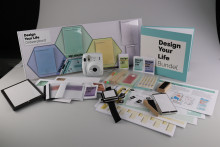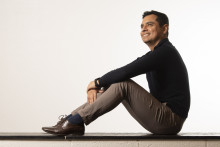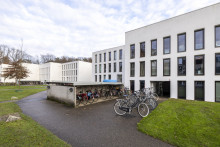You made a toolbox?
Van Huizen: ‘We developed a kit with instructions, prototype materials and plans that guide young adults with autism in creating their own assistive technology, which can be anything that provides comfort for their way of living. We saw that social robots and such are often developed to compensate for social shortcomings or make the user abandon stereotypical on-the-spectrum behaviour like minimal eye contact or hand flapping. We believe that autism first and foremost is just another way of looking at the world due to a different neurological build, in which there is no right or wrong. The toolkit, a project initiated by UT researcher Jelle van Dijk, aims to let young adults with autism deal better with a world that isn’t originally designed for them, without throwing their own identity overboard.’
Why should that identity be kept on board?
‘Because it has something to do with emancipation, the recognition of who you are and that it’s okay. I think that people often grow up with the idea that autism is something abnormal by definition. When you find yourself on the spectrum, that brings you down of course. Many people try to mask their autism, especially young adults, and that won’t make them happy. Instead, embracing their uniqueness can. Assistive technology is then there to help as interface at points of friction between them and the world.’
How can young adults make use of the tools?
‘In eight two-hour sessions, you would go through a cycle of five design phases alongside curated materials that help you in your creative process. In every phase there is a set of design activities you can chose from. Personally, I find the routine-mapping activity very interesting. We know for instance that routines can be less flexible for people with autism. From the standpoint of neurodiversity, we encourage the user to take ownership of their routines which may seem crazy and inefficient to a neurotypical person, and look for ways to make that routine work for themselves. Thereby we hope to trigger the user’s own enthusiasm and motivation, instead of providing some product and demand it’s use.’
Could you elaborate on that?
‘Yes, neurodiversity is a concept and movement that says: being on the spectrum must be seen as just another way of being present in our world, not as an alienated deviation from the neurotypical majority. Neurodiversity is incorporated in the sense that our toolkit empowers the user to tinker about and live their needs, provide self-knowledge and the assistive technology, thereby helping the user to integrate their neurodiverse uniqueness and live a more resilient life.’
How will the toolkit find its way into society?
‘In two ways actually. The first one is more formal, namely through classic healthcare infrastructure. We already work together with partners who are implementing the toolkit in their counselling. We hope that our toolkit will be offered further as training or coaching in addition to regular treatments like psychotherapy and emotion regulation training. Furthermore, we introduced our toolkit to autism-led maker movements and online communities who approach the kit differently than care providers. Through their engagement, we hope to achieve further dissemination and receive valuable feedback.’
How much will it cost?
‘Haha, that’s not on our priority list yet, though we would like the toolkit to be openly available in the end. At the moment we are mainly evaluating and redesigning the toolkit. So far, we’ve worked mostly with young adults who have average to high IQs and were capable to engage in the creative process and co-designing. We want to know if the toolkit is also usable for people on the more intense bounds of the autistic spectrum.’








